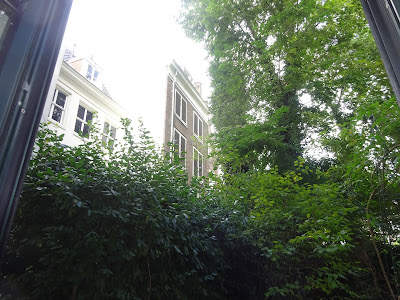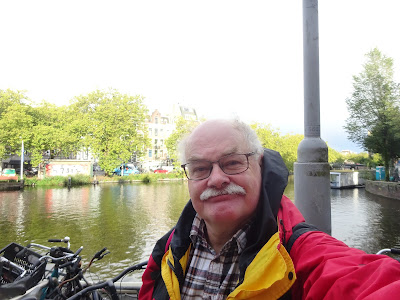 |
| North East Baseball League Final IJ |
 |
| North East Baseball League Final |
 |
| North East Baseball League Winners Newcastle Wings |
The National Monument commemorate the casualties of the Netherlands who were lost during World War Two and subsequent conflicts. It is located at Dam Square in Amsterdam.
.JPG) |
| National Monument Amsterdam |
.JPG) |
| National Monument Amsterdam |
.JPG) |
| National Monument Amsterdam |
On 10th May 1940 the Germans invaded the Netherlands, a neutral country, and without a formal declaration of war. The Dutch armed forces surrendered on 15th May following the bombing of Rotterdam the previous day. The country remained under occupation until the allies launched Operation Market Garden in September 1944 and the liberation of the Netherlands began. Liberation was finally accomplished with the surrender of German forces in the Netherlands on the eve of 5 May 1945, three days before the general capitulation of Germany.
During the conflict 205,901 Dutch men, women and children died of war-related causes, of which 107,000 were victims of the Holocaust. Another 30,000 people died in the Far East fighting the Japanese or in camps as Japanese POWs.
The National Monument was unveiled by Queen Juliana of the Netherlands on 4 May 1956
.
 |
| National Monument Amsterdam Unveiling May 4th 1956 |
 |
| National Monument 1956 Dam Square Amsterdam |
 |
| Dam Square 2024 |
On 10th May 1940 Germany invaded the Netherlands and after brief fighting the Dutch armed forces surrendered on 15th May following the bombing of Rotterdam. The German occupation of the Netherlands began on 17th May.
 |
| Dam Square 1940 |
The first part of the Netherlands liberated during the Second World War was around Maastricht by troops from the US 30th Infantry Division on 12th September 1944.
Allied Forces liberation of the Netherlands continued with Operation Market Garden liberating a corridor from the Belgian Border to Nijmegen. The Canadian Army advanced along the coast pushing in to the Netherlands till only the Western areas were still occupied when the German forces capitulated on 5th May 1945.
On 7th May 1945 crowds began to gather in Dam Square in Amsterdam to celebrate the end of the war and welcome their liberators. A reconnaissance patrol from the 49th (West Riding) Division entered Dam Square encountering Germans driving through the square.
 |
| 49 (WR) Division Recce pass Germans Dam Square |
The British withdrew from the square leaving it up to the Dutch Resistance to disarm the German Troops.
 |
| Dutch Resistance disarm German Troops Dam Square |
As the Dutch Resistance began disarming German troops one of whom refused and shots were fired. German soldiers in the Groote Club (Grand Club) went to the windows, balconies and on to the roof and began to fire into the celebrating crowds. The crowds fled the square or tried to take cover from the shots.

Crowds under fire in Dam Square
Scouts, red cross workers and nurses tended to the wounded.
 |
| Tending to the wounded Dam Square |
 |
| Liberated Amsterdam |
In 1947 a commemorative plaque to those killed in the Dam Square Shooting was unveiled on the facade of the Groote Club at the corner of the Dam and Kalverstraat.
.JPG) |
| Groote Club building Dam Square |
.JPG) |
| Dam Square shooting commemorative plaque |
.JPG) |
| Dam Square shooting commemorative plaque |
Anne Frank was Jewish Girl who maintained a diary whilst hiding with her family from Nazi persecution during the German Occupation of the Netherlands in the Second World War.
 |
| Anne Frank |
In May 1940 the Germans invaded the Netherlands and occupied the country. They began enacting anti Jewish laws and many Jews began to go into hiding. Amongst those who went into hiding were Otto Frank, his wife Edith and two daughters, Margot and Anne. Otto's family were of German descent, Otto having fought for Germany during World War One. They had moved to Amsterdam in 1934 when Hitler came to power and began persecuting the Jews.
On 5th July 1942 Otto Frank went into hiding when 16 year old Margot received a call-up notice requiring her to relocate to a work camp. They moved into the top three floors of an annex behind the building where Otto worked on the Prisengracht.
 |
| Anne Frank House Otto's Workplace Prisengracht |
 |
| Otto's Workplace Prisengracht Annex to rear of the building |
 |
| Anne Frank House Building Plan |
 |
| Anne Frank House Secret Annex Plan |
The Secret Annex could be reached via a door disguised as a bookcase.
 |
| Access to the Secret Annex |
They were joined a week later by the Van Pels family, Hermann, Auguste, and their 16-year-old son Peter. In November Fritz Pfeffer, a dentist and friend of the Frank family joined those in hiding.
Supporting those in hiding in the Secret Annex were work colleagues of Otto Frank, Victor Kugler, Johannes Kleiman, Miep Gies, and Bep Voskuijl. Together with Miep Gies' husband Jan, and Bep Voskuijl's father, they supplied food and news of the war.
Anne Frank had received a diary for her twelfth birthday in June 1942 just before the Frank family went into hiding. She immediately began to record her thoughts and experiences in that diary.
 |
| Anne Frank's First Diary |
She maintained the original diary until it was full then continued in a series of notebooks throughout the time in hiding until the Secret Annexe was raided by the Gestapo and it's occupants arrested.
 |
| Anne Frank's Diaries and Notebooks |
All those who were in hiding would end up in Concentration Camps, with the only Otto Frank surviving the war. Anne Frank perished in Bergen-Belsen in February or March 1945 aged fifteen. Her sister Margot also died in Bergen-Belsen.
 |
| Anne / Margot Commemoration Bergen-Belsen |
After the war Otto returned to Amsterdam where he was given Anne's diary and note books by Miep Gies who had found them and kept them safe after Secret Annexe had been raided.
The diaries were first published in Dutch on 25th June 1947 under the title of the Diary of a Young Girl.
_-_front_cover,_first_edition.jpg) |
| Diary of a Young Girl 1947 |
It was subsequently published in more than 70 languages and over 36 million copies produced.
 |
| Anne Frank Dairy Multi Languages |
 |
| Amsterdam Centraal Station |
 |
| Amsterdam Tower |
 |
| Hotel Boutique View |
 |
| Hotel Boutique View canal |
 |
| Hotel Boutique View VM |
 |
| Hotel Boutique View room view |
 |
| Hotel Boutique View room View at night |
 |
| Hotel Americano |
 |
| Hotel Americano Breakfast Room |
 |
| Hotel Americano VM Breakfast |
 |
| Dam Square |
 |
| Dam Square Royal Palace |
 |
| Dam Square IJ VM |
 |
| National Memorial |
 |
| Paleissstraat - Singel |
 |
| Amsterdam Tram Koningsplein - Singel |